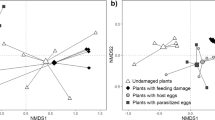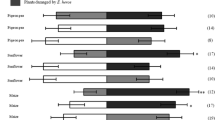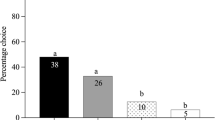Abstract
Diglyphus isaea Walker is a larval ectoparasitoid used in biological pest control against the American serpentine leaf minerLiriomyza trifolii Burgess. We studied the parasitoid's host searching behavior, using olfactometric methods. Our data show that the parasitoids locate host larvae (a leafmining dipteran) on the basis of volatile signals released by the plant-host complex. FemaleD. isaea are strongly attracted to the odors arising from damaged bean plants, whereas they show practically no response to intact plants. The results of our chemical analyses showed that about 15 components were present, two of which,cis-3-hexen-1-ol and 4-hydroxy-4-methyl-2-pentanone, were present in significantly larger quantities in the leaf extracts from mined or damaged bean plants than in those from healthy plants. The damage inflicted by the host larvae on these plants triggers the release of larger amounts of these substances, which probably lead the parasites to their hosts. The compounds thus act as synomones.
Similar content being viewed by others
References
Bekkaoui, A., andThibout, E. 1993. Role of the cocoon ofAcrolepiopsis assectella (Lepidoptera: Hyponomeutoidae) in host recognition by the parasitoidDiadromus pulchellus (Hymenoptera: Ichneumonidae).Entomophaga 38:101–113.
Buttery, R. G., andLing, L. C. 1987. Fresh tomato aroma volatiles: A quantitative study.J. Agric. Food. Chem. 35:540–544.
Buttery, R. G., Ling, L. C., andChan, B. G. 1978. Volatiles of Corn kernels and husks: Possible corn ear worm attractant.J. Agric. Food. Chem. 26:866–869.
Buttery, R. G., Xu, C. J., andLing, L. C. 1985. Volatile components of wheat leaves (and stems): Possible insect attractants.J. Agric. Food Chem. 33:115–117.
Cantelo, W. W., andJacobson, M. 1979. Corn silk volatiles attract many pest species of moth.J. Environ. Sci. Health. A14:695–707.
Dicke, M., andMinkenberg, O. P. J. M. 1991. Role of volatile infochemicals in foraging behavior of the leafminer parasitoid,Dacnusa sibirica Telenga.J. Insect Behav. 4:489–500.
Dicke, M., andSabelis, M. W. 1988. How plants obtain predatory mites as bodyguards.Neth. J. Zool. 38:148–165.
Dicke, M., andSabelis, M. W. 1989. Does it pay plants to advertise for bodyguards? Toward a cost benefit analysis of induced synomone production, pp. 341–358,in H. Lambers, M. Cambridge, H. Konings, and Th. Pons (eds.). Causes and Consequences of Variation in Growth Rate and Productivity of Higher Plants. SPB Academic Publishing, The Hague.
Dicke, M., Van Beek, T. A., Posthumus, M. A., Ben Dom, N., Van Bokhoven, H., andDe Groot, A. E. 1990. Isolation and identification of volatile kairomone that affects acarine predator prey interactions: Involvement of host plant in its production.J. Chem. Ecol. 16:381–396.
Dickens, J. C., Jang, E. B., Light, D. M., andAlford, A. R. 1990. Enhancement of insect pheromone response by green leaf volatiles.Naturwissenschaften 77:29–31.
Drost, Y. C., Lewis, W. J., andTumlinson, J. H. 1988. Beneficial arthropod behavior mediated by airborne semiochemicals: V. Influence of rearing method, host plant and adult experience on host searching behavior ofMicroplitis croceipes Cresson, a larval parasitoid ofHeliothis.J. Chem. Ecol. 14:1607–1616.
Elzen, G. W., Williams, H. J., andVinson, S. B. 1983. Response by the parasitoidCampolitis sonorensis (Hymenoptera: Ichneumonidae) to chemicals (synomones) in plants: Implications for host habitat location.Environ. Entomol. 12:1872–1876.
Elzen, G. W., Williams, H. J., andVinson, S. B. 1987. Comparative flight behavior of parasitoidsCampoletis sonorensis andMicroplitis croceipes.Entomol. Exp. Appl. 45:175–180.
Guerin, P. M., Staedler, M., andBuser, H. R. 1983. Identification of host plant attractants for the carrot fly,Psila nosae.J. Chem. Ecol. 9:843–861.
Hamilton-Kemp, T. R., Andersen, R. A., Rodriguez, J. G., Loughrin, J. H., andPatterson, C. G. 1988. Strawberry foliage headspace vapor components at periods of suceptibility and resistance toTetranychus urticae Koch.J. Chem. Ecol. 14:789–796.
Hamilton-Kemp, T. R., Rodriguez, J. G., Archbold, D. D., Andersen, R. A., Looghrin, J. H., Patterson, C. G., andLowry, S. R. 1989. Strawberry resistance toTetranychus urticae Koch: Effects of flower, fruit, and foliage removal comparisons of air vs. nitrogen entrained volatile compound.J. Chem. Ecol. 15:1465–1473.
Hefetz, A. andLloyd, H. A. 1983. Identification of new components from anal glands ofTapinoma simrothi Pheonicium.J. Chem. Ecol. 9:607–614.
Hernandez, H. P., Hsieh, T. C. Y., Smith, C. M., andFischer, N. H. 1989. Foliage volatiles of two rice culticars.Phytochemistry 28:2959–2962.
Jordan, E. D., Hsieh, T. C. Y., andFischer, N. H. 1992. Volatile compounds from leaves ofCeratiola ericoïdes by dynamic headpace sampling.Phytochemistry 31:1203–1208.
Kennedy, B. 1984. Effect of multilure and its components on parasitesScolytus multistriatus (Coleoptera: Scolytidae).J. Chem. Ecol. 10:373–385.
Leconte, C., andThibout, E. 1981. Attraction d'Acrolepiopsis assectella, en olfactomètre, par des substances allélochimiques volatiles d'Allium porrum.Entomol. Exp. Appl. 30:293–300.
Lyon, J. P. 1976. Les populations aphidiennes en serre et leur limitation par utilisation expérimentale de divers entomophages.ACTA Hortic. 58:405–409.
Lyon, J. P. 1986.Liriomyza trifolii (Burgess), les problèmes posés et les possibilités de contrôle biologique.Def. Veg. 234:6–11.
Minkenberg, O. P. J. M., andVan Lenteren, J. C. 1987. Evaluation of parasitic wasps for biological control of leafminers,Liriomyza sp., in greenhouse.Bull. OILB/SROP 10:115–120.
Monteith, L. G. 1956. Influence of host movement on selection of hosts byDrino Bohemica Mesn. (Diptera: Tachinidae) as determined in an olfactometer.Can. Entomol. 88:583–586.
Mudd, A., Walter, J. M. M., andCorbet, S. A. 1984. Relative kairomonal activities of 2-Acylcyclohexane-1,3-diones in eliciting oviposition behavior from parasiteNemeritis canescens (Grav.).J. Chem. Ecol. 10:1597–1601.
Nadel, H., andVan Alphen, J. J. M. 1987. The role of host and host-plant odours in the attraction of a parasitoid,Epidinocarsis lopezi to the habitat of its host, the cassava mealy bug,Phenacoccus manihoti.Entomol. Exp. Appl. 53:57–63.
Nedstam, B., Stengard, Hansen, L., andVan Lenteren, J. C. 1987. Proceedings of combined working groups on integrated control in greenhouses EPRS/WPRS. Budapest, Hungary, April 26–30, 1987. Bulletin of IOBC/WPRS 10.
Nordlund, D. A., andLewis, W. J. 1976. Terminology of chemical releasing stimuli in intraspecific and interspecific interactions.J. Chem. Ecol. 2:211–220.
Petitt, F. L., Turlings, T. C. J., andWolf, S. P. 1992. Adult experience modifies attraction of the leafminer parasitoidOpius dissitus (Hymenoptera: Braconidae) to volatile semiochemicals.J. Insect Behav. 5:623–634.
Ramachandran, R., Norris, D. M., Phillips, J. K., andPhillips, T. W. 1991. Volatiles mediating plant-herbivore natural enemy interactions: Soy bean looper frass volatiles, 3-octanone and guaiacol, as kairomones for the parasitoidMicroplitis demolitor.J. Agric. Food. Chem. 39:2310–2317.
Sauo, R., andTakeo, T. 1975. Increase ofcis-3-hexen-1-ol content in tea leaves following mechanical injury.Phytochemistry 14:181–182.
Stockel, J., Bar, M., Boidron, J. N., andBourgeois, G. 1987. Methodological approach to identify chemical oviposition stimulants from maize for European corn borer.J. Chem. Ecol. 13:557–567.
Takabayashi, J., andTakahashi, S. 1989. Effects of fecal pellet and synthetic kairomone on host searching and post oviposition behavior ofApanteles kariyai, a parasitoïde ofPseudaletia separata.Entomol. Exp. Appl. 52:221–227.
Takabayashi, J., Dicke, M., andPosthumus, M. A. 1991. Variation in composition of predator-attracting allelochemicals emitted by herbivore-infested plants: Relative influence of plant and herbivore.Chemoecology 2:1–6.
Takabayashi, J., Dicke, M., Takahashi, S., Posthumus, M. A., andVan Beek, T. A. 1994. Leaf age effects composition of herbivore-induced synomones and attraction of predatory mites.J. Chem. Ecol. 20:373–386.
Turlings, T. C. J., Tumlinson, J. H., andLewis, W. J. 1990. Exploitation of herbivore induced plant odors by host seeking parasitic wasps.Science 250:1251–1253.
Turlings, T. C. J., Tumlinson, J. H., Eller, F. J., andLewis, W. J. 1991. Larval-damaged plants: Source of volatile synomones that guide the parasitoidCotesia marginiventris to the microhabitat of its hosts.Entomol. Exp. Appl. 58:75–82.
Van Alphen, J. J. M., andVet, L. E. M. 1986. An evolutionary approach to host finding and selection, pp. 23–60,in J. K. Waage, and D. J. Greathead (eds.). Insect Parasitoids. Blackwell, London.
Van Lenteren, J. C., andWoets, J. 1988. Biological and integrated pest control in greenhouses.Annu. Rev. Entomol. 33:239–269.
Vet, L. E. M., andGroenwold, A. W., 1990. Semiochemicals and learning in parasitoids.J. Chem. Ecol. 16:3119–3135.
Vinson, S. B. 1975. Source of material in the tobacco budworm which initiates host-searching by the egg-larval parasitoidChelonus texanus.Annu. Entomol. Soc. Am. 68:381–384.
Vinson, S. B. 1976. Host selection by insect parasitoids.Annu. Rev. Entomol. 21:109–133.
Vinson, S. B. 1981. Habitat location, pp. 97–120,in D. A. Nordlund, R. L. Jones, and W. J. Lewis (eds.). Semiochemicals—Their Role in Pest Control. John Wiley & Sons, New York.
Vinson, S. B., Barfield, C. S., andHenson, R. D. 1977. Oviposition behavior ofBracon mellitor, a parasitoid of the boll weevilAnthonomus grandis. II. Associative learning.Physiol. Entomol. 2:157–164.
Visser, J. M., Van Straten, S., andMaarse, H. 1979. Isolation and identification of volatiles in the foliage of potatoSolanum tuberosum, a host plant of the Colorado beetle,Leptinotarsa decemlineata.J. Chem. Ecol. 5:13–25.
Wallbank, B. E., andWheatley, G. A. 1976. Volatile constituents from cauliflower and other crucifers.Phytochemistry 15:763–766.
Weseloh, R. M. 1981. Host location by parasitoids, pp. 97–120,in D. A. Nordlund, R. L. Jones, and W. J. Lewis (eds.). Semiochemicals—Their Role in Pest Control. John Wiley & Sons, New York.
Whitman, D. W. 1988. Allelochemical interactions among plants, herbivores and their predators, pp. 11–64,in P. Barbora, and D. Letourneau (eds.). Novel Aspects of Insects-Plants Interactions. John Wiley & Sons, New York.
Whitman, D. W., andEller, F. J. 1990. Parasitic wasps orient to green leaf volatiles.Chemoecology 1:69–76.
Whittaker, R. H., andFeeny, P. P. 1971. Allelochemics: Chemical interactions between species.Science 171:757–770.
Wolfender, J. L., Maillard, M., andHostettmann, K. 1993. Liquid chromatographic-thermospray mass spectrometric analysis of crude plant extracts containing phenolic and terpene glycosides.J. Chromatogr. 647:183–190.
Zagatti, P. 1985. Approche évolutive du comportement précopulatoire chez les Lépidoptères Ditrysiens. Thèse d'Université, Paris VI. 191 pp.
Author information
Authors and Affiliations
Rights and permissions
About this article
Cite this article
Finidori-Logli, V., Bagnères, AG. & Clément, JL. Role of plant volatiles in the search for a host by parasitoidDiglyphus isaea (Hymenoptera: Eulophidae). J Chem Ecol 22, 541–558 (1996). https://doi.org/10.1007/BF02033654
Received:
Accepted:
Issue Date:
DOI: https://doi.org/10.1007/BF02033654




